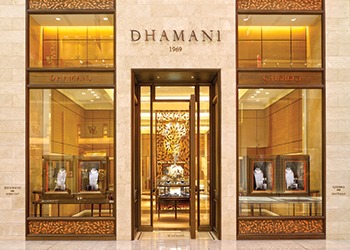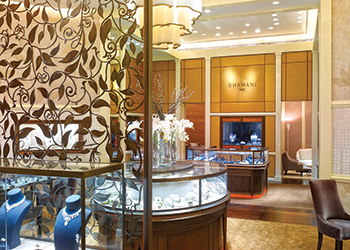 Dhamani 1969 ... stately entrance.
Dhamani 1969 ... stately entrance.
Dhamani’s new boutique in Dubai celebrates works of art
Striking a balance between traditional materials and innovative luxury finishes has been a key element in the design and fit-out of Dhamani 1969. The new luxury jewellery boutique, which opened recently in Dubai, UAE, features handcrafted jewellery and cut gemstones from one of the world’s most exclusive jewellery brands.
The 3,500-sq-ft boutique, located in Dubai Mall, has been designed by Callison.
With an elegant marble and bronze façade, sophisticated custom surfaces and signature lighting treatments, Callison has created a boutique that celebrates each of Dhamani’s handcrafted masterpieces as individual works of art. Work on concept development for Dhamani 1969 began in January 2013 and was completed in June 2014.
Commenting on the project, Callison principal, Dave Scurlock, says: “Dhamani approached Callison to design a boutique concept for the remodel of its existing store in the Dubai Mall, which would be renamed Dhamani 1969.
“The company wanted the boutique to re-imagine and transform its retail image, and assert its position among the world’s most exclusive luxury jewellery brands. Given the unique character of each handcrafted piece, it was paramount that the new store design would embody luxury, quality and the standard of service that the Dhamani customer expects.”
Callison’s success in creating a design befitting the brand has not only earned it renown in the UAE circles but also internationally, with Dhamani 1969 having won several design awards recently including the 2015 ICSC Viva ‘Best of the Best’ Retail Store Award, the Gold Award for Retail Store Design Excellence at the ICSC (International Council of Shopping Centers)/MECSC (Middle East Council for Shopping Centres)Middle East Shopping Centre and Retailer Awards, and the Gold Award for Hardline Specialty Stores at the ARE (Association for Retail Environments) Design Awards.
Design
The design of the Dhamani 1969 boutique reflects a reference to classic luxury and the timelessness of Dhamani artistry. Careful consideration has been given to all store elements, from storefront to interior materials to fixtures and merchandise displays, with the goal of achieving a complete expression of world-class luxury.
Callison has created a design language for Dhamani 1969 to give customers an immersive experience in luxury and style. The design team envisioned the boutique as a gallery-like space – a classical salon in which to view the ‘art of Dhamani’ – similar to art salons found in grand, residential estates, according to Scurlock.
The design idea of ‘modern glamour’ has been a guide to the architectural character and interior design, a reference to classic luxury and artistry, crafted with modern embellishments. These ideas have been carefully woven with the Dhamani brand language to embody its heritage in the store environment.
Inspiration
Callison has used marble, bronze, dark woods and rose gold to create the overall ambiance.
“Then, we created ways to express iconic brand elements, such as the Dhamani floral pattern and signature bronze and rose gold, into the design. The storefront, entry screen as well as the store’s fixturing and displays are intended to function together as a unique and recognisable world-class luxury brand identity,” says Scurlock.
The Dhamani family story and the existing branding of its retail business have been significant inspirations for this project, according to Scurlock.
“These two elements were seen as a parallel to classic luxury fashion and jewellery design houses. We were inspired to develop a luxury jewellery salon for the House of Dhamani,” he says.
The boutique is separated, in plan, into three ‘salons’. Each salon has different characteristics and is intended for differing merchandise displays as part of the customer’s journey.
Salons One and Three use a similar colour scheme with greater contrasts - gold-tone silks, richer metals and wood accents. Salon Two is the centre room, and uses lacquered woods, mirrors, Venetian plaster and mother-of-pearl accents to create the showcase of the boutique. The colour scheme is based on using unified families of finishes with zones of contrast and special finishes to create areas of interest.
 |
|
Salon Two at the boutique ... exquisite finishes. |
Finishes
“Following our design concept, we wanted to utilise recognisable brand elements, colours, forms and patterns to create a sense of drama through contrasts between materials and product presentations,” says Scurlock.
Cream-coloured Italian marble, with bronze and rose gold accents, has been used to create a classically-styled storefront. Salons One and Three surround guests in gold silk-covered wall panels with rose gold trim, custom carpets and hand-rubbed bronze finishes inset with rose gold. Products are displayed against dark velvet backgrounds with specialty lighting to enhance the beauty of the jewellery.
Salon Two has been designed to have a very feminine character and uses lighter finishes, plasters and mother-of-pearl wall covering to create a stunning backdrop for specialty jewel displays and coloured gemstones. Here, the signature Dhamani bronze screen rises from floor to ceiling to create a sense of privacy and exclusivity, as well as drama. The signature Dubai Cut diamond presentation is the highlight of Salon Three.
“It was important to the Dhamani family that we recognise the heritage elements of their brand, the way the logo and mark were used, and the signature Dhamani leaf pattern,” says Scurlock. “Of course, in this type of boutique, specialty lighting treatments and the inclusion of enhanced security systems were part of the challenges, since we needed to integrate these functional elements in a way that did not detract from the overall character of the design.”
Private consultation rooms have also been provided so that special customers and VIP visitors can view collections in more exclusive and private surroundings.
“This new boutique design was a complete departure from previous Dhamani retail stores, so all the fit-outs and furnishings were developed specifically for this project. Fit-out contractor FDC International was an integral part of the team and worked tirelessly to create many of the custom fabrications and details that were unique to the project. Due to the intensive coordination between lighting, security and other requirements, many of the components were produced as mock-ups, undergoing several reviews before the final fabrication,” adds Scurlock.
Furnishings were selected and sourced from all over the world to maintain the design character and achieve the final outcome. Many of the materials were sourced from Europe and the US.
FDC International worked closely with the Dhamani and Callison teams to ensure all materials arrived on time and were installed with the highest standards of workmanship. A number of the specialty finishes on this project have been used for the first time in Dubai or the UAE, including custom lighting fixtures, fabrics, carpets and wall coverings.
Challenges
Due to time constraints for the fit-out, and the high level of finish required, much of the boutique was constructed in the FDC International shop in Kuwait. Given the size and scale of some of the design elements, shipping and installation were particularly challenging, Scurlock points out.
“The boutique is built to an extremely high level of finish, and dimensional tolerances were critical. The contractor has achieved a very high standard of precision and the design team has made numerous trips to Kuwait during the project to review mock-ups,” he adds.
A beautiful, hand-made bronze screen, in a floral pattern reminiscent of Jaipur pottery, sits at the heart of the boutique.
According to Scurlock, creating this centrepiece was a complex process. “The 13-ft-tall screen was laser cut from 5-mm-thick metal, then cut into individual sections and hand-assembled with 7,000 individual welds. Each leaf and every branch was individually hand-ground and hand-rubbed with a bronze finish. The entire process took more than a month to complete,” he elaborates.
Key players
The teamwork and collaboration between the Dhamani family and Callison has been critical to achieve the perfect look for the boutique, says Scurlock.
Scurlock led the design team with Callison directors Christian Jochman and Erik Mueller-Ali as lead designers for the project. Sean Hennessy Lighting Design created the lighting treatments. The fit-out team, led by Elie Assamad from FDC International, was integral to the process from the conclusion of design to store opening.
Commenting on trends in the retail sector, Scurlock says: “Consumers are more sophisticated and educated about products than ever before. Retail store designs are challenged to become holistic, engaging environments that capture the imagination of the consumer. They are also challenged to cultivate stories and curate products and services that create memorable and branded shopping experiences. Dhamani 1969 is an excellent example of the kind of retail environment that is a physical representation of the attributes of Dhamani luxury.”
About the influence of interior design on sales and the performance of a shop, he says: “Retail store design and the interior design character play a key role in the sales and performance of retail stores. Stores should be integrally tied to the client brand, customer needs and expectations.
“Successful retail environments embody brands and create compelling, emotional experiences for customers. Successful store design and brand positioning result in greater brand loyalty, an increase in sales and higher customer engagement.”
Scurlock is based at Callison’s Seattle office. With more than 27 years of experience in designing retail environments, he has worked with a diverse group of leading retailers and developers throughout Asia, the Middle East, Europe and the US. He has led teams in the development of innovative and award-winning store designs for both national and international clients, providing a balance of retail best practices, international insights and relevant cultural context for his projects. Scurlock is a member of ICSC, ARE and RDI (Retail Design Institute). He also sits on design:retail magazine’s editorial advisory board.
Founded in 1975, Callison is a global architectural firm and a part of the Arcadis global network, specialising in the retail, mixed-use, corporate, hospitality, healthcare, multifamily residential, mission critical and high-rise markets worldwide. With more than 1,000 employees and 11 offices on three continents, Callison is one of the largest design firms based in the US.
Callison has worked on numerous projects around the world, such as Bloomingdale’s in Dubai; The Pearl-Qatar and 51 East, both in Doha, Qatar; Watches of Switzerland in London, UK; and Kid’s Cavern in Macau, China.








.jpg)




.jpg)




























.jpg)
































